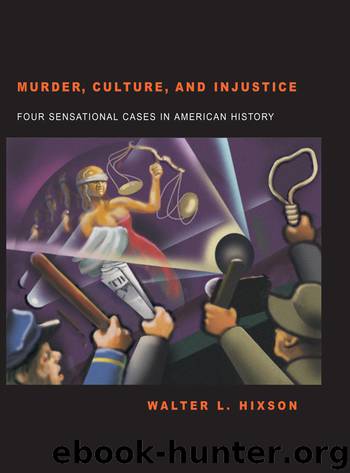Murder Culture and Injustice by Walter L. Hixson

Author:Walter L. Hixson
Language: eng
Format: epub
ISBN: 9781931968546
Publisher: University of Akron Press
In the days after the murder of his wife, Sam Sheppard (left) appeared in public wearing a neck brace as a result of the injuries he suffered in a struggle with the perpetrator of the crime. The police, coroner, and newsmen expressed skepticism about Sam’s injuries, but they were well documented by attending physicians. Class also played a role in the Sheppard case, as much of the working and middle class public perceived the Sheppards as attempting to use their wealth and power to insulate Sam from the criminal justice system. Sam is pictured here with his equally nattily attired brother, Richard, and sister-in-law Dorothy Sheppard. Courtesy of Cleveland State University Library
Whereas Sam Sheppard remained silent on the advice of his attorneys, police suspicion of him quickly found its way into the newspapers. The city had three newspapers, including the especially hard-hitting Scripps-Howard paper, the Cleveland Press, the largest newspaper in Ohio with a circulation of 310,000. From the outset the Press published information that could only have been supplied by the police and which clearly had been intended to implicate Sheppard in his wife’s murder. All other possible explanations of the crime, including Sheppard’s consistent personal account, were virtually ignored.
An ongoing circulation war prompted competition among the newspapers, fueling sensational coverage of what was indeed, beyond question, a sensational murder case. Bold headlines referred simply to “Marilyn,” like the glamorous movie star Monroe, and a salacious atmosphere prevailed in the large, yet provincial, Midwestern city.
Much of the public in Cleveland, a hard-working town of blue collar and middle management families, readily embraced the official view that Sam’s wealthy family had been summoned to help him cover up the crime. While gender played a key role in the Lizzie Borden case, and ethnic prejudices in the Hauptmann case, class anxieties molded public opinion in the Sheppard case. Many believed that the Sheppards were brazenly thumbing their noses at the police. Sam “must be laughing secretly at the whole spectacle,” the Press averred. An outraged public concluded that Sam Sheppard thought he could get away with murder simply because he was a rich and well-connected physician.
The Press, as its longtime editor Louis Seltzer later admitted, orchestrated a campaign to bring Sam Sheppard to “justice.” On July 16 the Press condemned police and public officials for their “tragic mishandling of the Sheppard murder investigation.” Rumors of Sheppard’s alleged sexual liaisons with other women laced the published accounts, further inflaming public opinion.
The press reported, accurately, that Sheppard had declined requests that he take a lie detector test. The physician explained to police that he did not trust such a test, which, as he understood it, might not be reliable because of his “nearness to the tragedy.” Sheppard’s attorneys agreed that a lie detector test in the midst of the hostile public climate, and with their client still recuperating from injuries and trauma, would be unreliable and potentially misleading. Moreover, Sheppard and his attorneys believed that officials convinced of his guilt would set up the test in such a way as to ensure his failure.
Download
This site does not store any files on its server. We only index and link to content provided by other sites. Please contact the content providers to delete copyright contents if any and email us, we'll remove relevant links or contents immediately.
Mindhunter: Inside the FBI's Elite Serial Crime Unit by John E. Douglas & Mark Olshaker(8707)
Wiseguy by Nicholas Pileggi(5320)
Hitman by Howie Carr(4830)
Room 212 by Kate Stewart(4741)
Secrecy World by Jake Bernstein(4390)
Killers of the Flower Moon: The Osage Murders and the Birth of the FBI by David Grann(4191)
Breaking Free by Rachel Jeffs(4013)
Papillon (English) by Henri Charrière(3908)
Killers of the Flower Moon by David Grann(3753)
Say Nothing by Patrick Radden Keefe(3726)
American Kingpin by Nick Bilton(3510)
The Secret Barrister by The Secret Barrister(3424)
Molly's Game: From Hollywood's Elite to Wall Street's Billionaire Boys Club, My High-Stakes Adventure in the World of Underground Poker by Molly Bloom(3337)
Mysteries by Colin Wilson(3253)
In Cold Blood by Truman Capote(3140)
I'll Be Gone in the Dark by Michelle McNamara(2888)
Signature in the Cell: DNA and the Evidence for Intelligent Design by Stephen C. Meyer(2879)
Rogue Trader by Leeson Nick(2829)
Bunk by Kevin Young(2809)
